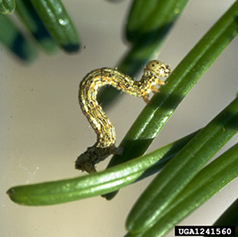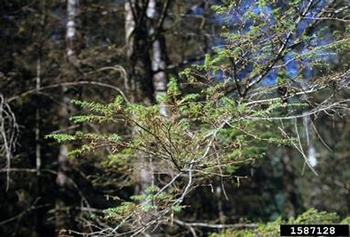
EPPO Alert List – Lambdina fiscellaria (Lepidoptera: Geometridae)
Hemlock looper
Why
Lambdina fiscellaria was recently identified as a potential threat to Sitka spruce plantations in Ireland, and to Nordic coniferous forests when screening for potential pests associated with trade of ornamental plants. The EPPO Panel on Phytosanitary Measures recommended its addition to the EPPO Alert List.
The hemlock looper is split into three subspecies, on the basis of differences in feeding preferences of the larval stages, but there are no morphological differences:
Lambdina fiscellaria fiscellaria – eastern hemlock looper
Lambdina fiscellaria lugubrosa – western hemlock looper
Lambdina fiscellaria somniaria – western oak looper

Adult (L. fiscellaria somniaria) – JE. Dewey
USDA Forest Service, Bugwood.org

Larva (L. fiscellaria lugubrosa) – JE. Dewey
USDA Forest Service, Bugwood.org

Defoliation (L. fiscellaria lugubrosa) – Bruce Hostetler
USDA Forest Service, Bugwood.org
Where
L. fiscellaria occurs North America (Canada and USA). The different subspecies of L. fiscellaria vary in their distribution. Lambdina fiscellaria fiscellaria is found in Eastern Canada and USA, Lambdina fiscellaria lugubrosa is found from Oregon north through to British Columbia and South-East Alaska, and Lambdina fiscellaria somniaria is found in Oregon, Washington and the south coast of British Columbia.
EPPO Region: Absent.
North America: Canada (British Columbia, New Brunswick, Newfoundland, Nova Scotia, Ontario, Prince Edward Island, Quebec), USA (Alaska, California, Connecticut, Georgia, Idaho, Maine, Massachusetts, Michigan, Minnesota, Montana, New Hampshire, New York, Ohio, Oregon, Pennsylvania, Rhode Island, Vermont, Washington, Wisconsin).
On which plants
The hemlock looper is very polyphagous, and its known hosts include both coniferous and deciduous trees. The preferred larval host plants vary depending on the subspecies and the diet of the first instars is more restricted than later instars. Major hosts include Abies balsamea (balsam fir), Picea glauca (white spruce), Tsuga spp. (hemlock), Picea sitchensis (Sitka spruce), Acer spp. and Quercus garryana. During outbreak years, larvae can be found feeding on a significant number of tree species as well as understory plants.
Damage
Damage to plants is caused by the larvae that feed on needles and leaves. During severe outbreaks, trees can be completely defoliated over large areas.
Dissemination
Adults can fly short distances. First instar larvae are capable of moving to find a suitable host, as eggs are often laid on old stumps, in mosses or on the forest ground. Pupae and egg masses may be present on wood, as well as on mosses and lichens that are harvested in forest. As the pest is mainly associated with forest areas, its introduction in the EPPO region with plants for planting is considered unlikely by the Irish Pest Risk Analysis.
Pathway
Plants for planting, wood, mosses and lichens harvested in forests? from areas where L. fiscellaria occurs.
Possible risks
L. fiscellaria occurs in regions with similar climates to the EPPO region, it has a wide host range and some host plants are widespread in the region. If it was introduced, it could cause similar outbreaks as in its area of origin. Current phytosanitary measures on wood of major hosts can mitigate the risk of entry but, during outbreaks, the pest may be associated with many plant species that are not regulated. The trade of mosses and lichens from USA to the EPPO region has recently increased and is not covered by any phytosanitary regulation.
Sources
CABI (2021) Lambdina fiscellaria (eastern hemlock looper). Invasive Species Compendium. CABI, Wallingford (GB). https://www.cabi.org/isc/datasheet/29749
Marinova‐Todorova M, Björklund N, Boberg J, Flø D, Tuomola J, Wendell M, Hannunen S (2020) Screening potential pests of Nordic coniferous forests associated with trade in ornamental plants. EPPO Bulletin 50(2), 249–267.
Tuffen MG (2018) Rapid Pest Risk Analysis (PRA) for Lambdina fiscellaria. Teagasc Dublin, Ireland. 79 pp.
Tuffen MG, Grogan HM (2019) Current, emerging and potential pest threats to Sitka spruce plantations and the role of pest risk analysis in preventing new pest introductions to Ireland. Forestry: An International Journal of Forest Research 92(1), 26–41. https://doi.org/10.1093/forestry/cpy036
EPPO RS
